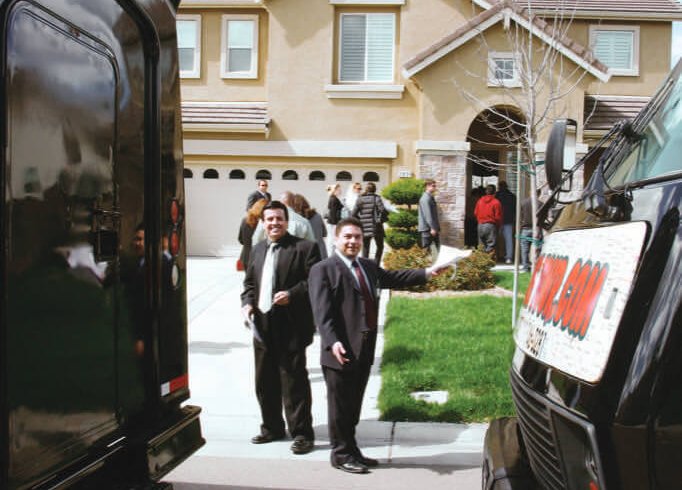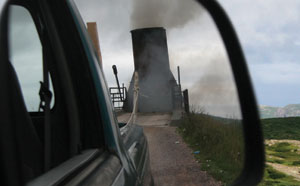The convoy rolled into Brookside, a collection of gated communities in Stockton, California, on a clear Saturday morning. Fountains arced from artificial lakes, but the streets were empty, and the double garage doors were all shut tight. Riverbrook Drive, Willowbrook Circle, and Brookside Road were quiet but for the creak of swinging For Sale signs and the ambient rush of Interstate 5. The place felt like Dodge before a gunfight.
We rode in a pair of black buses, their flanks plastered with images of big houses and cheering buyers. Blood red letters proclaimed: repohometour.com. With a gaggle of realtors and twenty-odd repo tourists, our bus was bursting. So were its sister ship and the half-dozen cars trailing behind.
We circled into Antique Place, a cul-de-sac ringed (according to the listing) with “executive” homes. The bus doors swung open.
“Vámonos!” bellowed realtor Jorge Espino, a man endowed with a salesman’s broad smile and a circus barker’s lungs. “Ten minutes, my friends!”
Smelling the blood of a fresh foreclosure, we charged across the sunburned lawn and up the concrete stoop of a beige stucco house. Shoes on, we dashed from room to room, up and down stairs, pawing scuffed drywall and soiled carpets, fingering scratches along walls. The house was barely nine years old, but it felt weary. Nobody had taken the time to patch the rough-edged holes in the drywall. You could feel the haste and despair of the erstwhile owners.
Espino stood in the vaulted foyer and hollered at us, “Beautiful house! Two thirty-four or best offer.”
“It went for five hundred just a couple of years ago,” interrupted one of Espino’s colleagues. “It’s basically a half-off sale!”
“Come on, who wants this house? Who’s at two twenty-one? Two twenty?” shouted Espino. He paused to check his watch.
“Okay, time’s up. All aboard! Vámonos!”
Thus began a typical day aboard the Repo Bus tour of Stockton, a farming town turned commuter haven an hour and a half east of San Francisco. Last year, more people lost their homes to foreclosure here than anywhere else in the United States except Detroit. That’s one in twenty homes. Americans are still passing around the blame for the crisis—to unscrupulous bankers, to blinkered lawmakers, to gullible homebuyers—but tragedy was the last thing on anyone’s mind this morning. Hell, Espino and his colleagues at Approved Financial and Real Estate had turned the ravaged housing market into a movable feast. There was pop and chips for everyone, and deals galore as we scavenged the suburbs for pieces of other people’s shattered American dreams. We hit a dozen houses in three hours. The bus vibrated with a euphoric sense of urgency, fuelled by the potential for easy riches.
We certainly weren’t alone in our quest. The foreclosure economy is booming. Repo tour operations have launched all across the US. The Internet is clogged with listings of bank-owned homes and “distressed sales.” This may seem a tad predatory, but boosters insist the repo economy is a force for good. Cesar Dias, founder of the Repo Home Tour, told me he and Espino were helping to heal America’s wounded neighbourhoods. It was a heartwarming idea, but as we barrelled through the burbs I began to wonder if the repo economy reflected a simple market correction, or a complete meltdown of the systems that have charged the growth of North American cities for half a century.
My fellow repo tourists were regular folks—a rainbow of races and ages. There was Liz, a stock analyst from New York who flew in to troll for deals after hearing about Stockton’s woes on TV. There was Jerry the retiree, looking for his third rental property. There were young families with bawling babies. A few tourists were looking to make a home here, but most wouldn’t dream of it. (“Are you kidding? I’d never take on this commute,” Liz told me.) The edge of the sprawlscape wasn’t a place to live. It was barely a place at all. It was a commodity to be bought low, then sold on the high tide of a rebounding economy.
Take Terry and Sarah Lane, who trailed the Repo Bus in their dusty Subaru Outback. Terry was a chemistry teacher at Lincoln High in Stockton. Sarah was a nurse who commuted to a hospital in the Bay Area three times a week. Neither of them liked the idea of working full time, and real estate was their ticket to freedom. Terry pulled out the baby seat from the crumb-crusted back bench of the Subaru so I could join them. As we followed the convoy north toward Spanos Park, Sarah munched on a Nutri-Grain bar and explained their strategy.
“Look,” she said, pointing out the window. “You can tell the foreclosed homes because the lawn is brown instead of green. The house is kind of dirty, cobwebby. That’s the kind of house we want.” Back in the heady days of double-digit price gains, Terry and Sarah bought a fourplex in town and sold it after four years, for a $274,000 profit. After Hurricane Katrina hit, they bought a condo in Mississippi, which they rented to a hurricane returnee. But there’s never been a better time to snap up deals than now, Sarah told me as we pushed our way into 3131 Autumn Chase Circle.
“Of course, we feel horrible for the people who got caught in the crash,” said Terry.
“We want to flip two houses a year,” Sarah cut in, scanning the foyer. “Look at this place. I love the staircase. I love the wood banisters. The foreclosure price is two eighty-five. We could sell it on the market in a few months for four hundred—easy.”
Most of the buyers, and their agents, seemed to have no problem decoupling their aspirations from the tragedies of the homeowners who went before them. They were players—and true believers—in the free market. It was as if they were atomized pieces of a system that required nothing more than greed to slosh its way back to equilibrium. “We’re doing the community a favour,” declared the fast-talking Dias. And when I asked him about the people who had lost the homes he was selling: “We don’t know. We’re just moving the inventory.”
This is an attractive world view, especially because it imbues the market with a seemingly magical quality that systems theorists call “emergence.” Think of a flock of birds in flight. By following simple, instinctive rules, thousands of starlings can form a flock that arcs, veers, and dives in tight formation without collisions. Or consider ants, which develop a sophisticated colony architecture with no architect, no command authority. A multiplicity of players, all responding independently to layers of stimulus and feedback with no consideration of the whole. Yet the whole does have order.
But can the seemingly emergent mind of the market really resolve the foreclosure crisis? It would be reassuring to think that the interventions of thousands of selfish buyers could patch the holes in America’s neighbourhoods. It would certainly add a righteous note to our hunt for hot deals. Unfortunately, this faith ignores the system dynamics of the city itself.
Urbanist Jane Jacobs used systems theory to show how cities organize themselves. In her seminal 1961 book The Death and Life of Great American Cities, she insisted that vibrant, safe, rational places emerged not from central planning, but from the multitude of interactions between people on sidewalks. Great cities were ordered not from the top down, but from the bottom up. Given enough time walking around and making choices about where to eat, shop, live, and play, people determined the optimal shape of the city. Technology critic Steven Johnson would later point out that Jacobs was talking about a system not unlike an ant colony, where ants organize themselves and their colony over time, partly by bumping into each other. Emergence.
The suburbs, on the other hand, are as rigid as a plastic ant farm. They were a subsidized venture born of political decisions: The federal government rolled out freeways. City councillors cut deals with developers, locking in sprawl plans sometimes before they had been considered by citizens or potential homebuyers. And while boom-time buyers may have seen the symbols of neighbourhood in lawns and saplings and quiet cul-de-sacs, what they experienced was a system designed for quick returns rather than community or resilience. One of Stockton’s most prolific sprawl developers, Alex Spanos, a generous contributor to local and national political campaigns, is now the 1,014th-richest man in the world, according to Forbes. But his subdivisions have turned farmland into an inflexible matrix of mortgage traps, car dependence, and social vulnerability.
On Sunday, I ditched the Repo Bus and looked for signs of life in Weston Ranch, a twenty-year-old subdivision just off I 5. It was desolate but for a couple of moving vans carrying beds and chairs and big-screens back to San Francisco. The empty houses felt like the false fronts of a movie set. Finally I spotted a late-middle-aged man in his garage. Patrick Crouts seemed as glad to see me as I was to see him, and he invited me inside his modest rancher for a tall glass of water.
“Those three are empty,” he said, nodding out the window toward the houses across the street, “and the house beside me, too. Just a few months ago, those folks over there, a Mexican family, were practising for their daughter’s quinceañera—her fifteenth birthday party—out front. It was so beautiful. But one night they just packed up and left.”
When he arrived from Silicon Valley back in 2002, Crouts thought he was moving to a community. Now he has to pick up and recycle newspapers from the front steps of the abandoned homes that surround his, just to fool the thieves and vandals who target empty houses. Police estimate that there are ninety-odd gangs prowling Stockton’s suburbs. Crouts worries about the neighborhood kids whose parents spend three hours a day driving to and from work in the San Francisco Bay area. A sociologist, he’s been to the detention centres where so many wayward teens end up. He tells the kids left on his street to watch their language and stay away from gang colours. “Sure, Grandpa,” they tell him. Stern words can’t compete with a system perfectly designed for failure.
If this long-distance living was a set-up for social dysfunction, it also stoked the foreclosure crisis. Even Dias, whose job it was to hype suburban properties, admitted that spiking fuel costs hit Stockton as hard as rising mortgage rates. “Suddenly people went from spending $400 a month on gas to $800. They couldn’t afford to get to work anymore.” It’s worth noting that while Stockton’s older downtown neighbourhoods, which attract fewer commuters, have seen some foreclosures, they have remained viable.
However, American suburbs aren’t the only places where the raw material of community—home—has been reduced to a speculative commodity, with ominous results. As the property market boom has gone global, cities around the world are being transformed by people looking to get rich quick. I saw it this year in Dubai, where a string of instant “communities” for scores of expatriates have been laid out across the Arabian Desert. Condos are flipped several times before the backhoes even touch the sand. The people who move in find themselves lost in an archipelago of disconnected towers; they spend their days stuck in traffic, just like Stockton’s commuters. And in my hometown of Vancouver, many thousands of homes sit empty while absentee owners contemplate the market. The darkened towers in downtown neighbourhoods like Coal Harbour feel like Stockton’s desolate suburbs writ vertical.
A solution to the crisis of the hollow neighbourhood certainly must employ the power of markets. But, more fundamentally, it requires us to develop a deeper understanding of the way complex systems like cities and markets work, and how we engage with them.
Theorists at the Helsinki University of Technology’s Systems Analysis Laboratory have proposed a useful framework. Dubbed “system intelligence,” it calls for people to acknowledge that we happen to be smarter than ants. More specifically, it refers to our capacity to see that the ways we move, the ways we live, and the ways we buy affect the world far beyond our immediate vision.
To use system intelligence is to recognize the feedback loops and interdependence within systems. “[It] starts by asking the question ‘What is the system?’ But then you have to acknowledge that you are one of the agents creating it,” explained the lab’s director, Professor Raimo Hämäläinen, when I called him to discuss the Repo Bus. “These people are creating the market as individual agents, even if the system seems dictatorial,” he said. A bid on a foreclosed property is not just a market response; it is a means of tinkering with systems. For example, demand for repo homes makes banks more likely to foreclose instead of negotiating with homeowners in crisis, while every suburban home purchase encourages more sprawl on the city’s fringe. It’s all connected.
System intelligence rewards those who think and act with a view beyond the urgency of the moment. Bankers could have saved billions by considering the natural trajectory of their sub-prime mortgage party, and the repo tourists could avoid their own crisis by considering the complex reasons for suburbia’s collapse. But there is also an ethical element to the kind of thinking Hämäläinen espouses. A notion of connectedness is what leads us to recycle, or take turns when merging in traffic, or reduce our carbon footprint. In the case of real estate, it might just as powerfully lead bankers, developers, and homebuyers to let go of the urgency of the hot deal. First they would have to admit that we are engaging not just in a market system, but in a system of urbanism, of community development, and—not to put too fine a point on it—of civilization.
There was little airspace for this kind of talk on the Repo Bus, despite Cesar Dias’s convenient moralizing. In the frantic universe of buy and flip, every bad was a potential good. I remember the moment at the end of the tour when we filed into a garage-fronted bungalow in Spanos Park East. A sea of shattered glass sparkled on the parlour floor. Apparently someone had broken in and put a boot to the gas fireplace.
“Uh-oh,” said Dias.
“Vámonos!” said Jorge Espino.
But Sarah Lane saw opportunity in those shards. “This is a huge break!” she enthused.
“All these places are going to fall apart in twenty years anyway,” Terry Lane said with a laugh as we filed out.
Down the street, Dias was fussing over the state of a front lawn. It was just the kind of lawn the Lanes look for: unkempt, unwatered, unloved.
“The bank should have come by and sprayed this,” he said.
“You mean watered it? ” I asked.
“No, sprayed it green. Painted it,” he said, as though it was obvious that the suburbs only needed to keep up appearances until the next round of sales.
“Someone really should call the city.”






